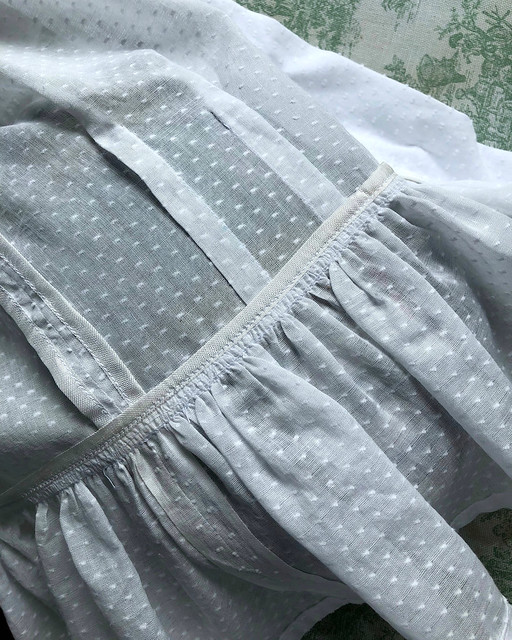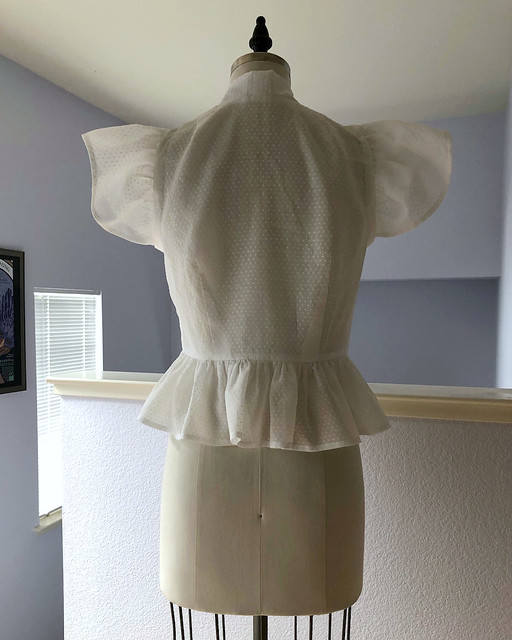Friday, May 29, 2020
A New Rønne, A New Pattern Company
I have come across the Rønne Blouse from time to time over the years, and it always looked like something I might want to sew, but for whatever reason, I never purchased the design. However, this month I decided that it would be perfect for a white dotted swiss that I found at an estate sale last year. And I am all about using stashed fabric these days!
I am not a fan of PDF patterns, but since this is a blouse, the pieces were not going to be all that large. I did encounter a problem with printing. The upper and lower borders would not show when the pattern was set at it's actual size (which is very important for sewing patterns, obviously). I suspect the issue is European paper sizes versus standard 8.5x11 paper that I have access to. I contacted the company and they were very responsive, however, my problem was not solved. Maybe it's just my computer with the issue, but I am pretty good at figuring those sorts of things out, and this one would not work for me no matter what I tried. I decided to go ahead without the upper and lower borders and do my best to match up cutting lines.
Seam lines matched each other throughout, so I must have been fairly accurate with my taping.
The pattern is described as beginner friendly, but I would have been a bit lost with the instructions had this been my first garment. Also, the instructions are not sent with the PDF pattern, they are available on the How to Do Fashion website, which took me a minute to figure out.
When I first began sewing with garment patterns, I used Big4 patterns, and they give a lot more information. For instance, this pattern simply says to finish the armhole with bias tape; no diagrams or explanations. It also seems that they would have you finish all of the short peplum edges, but later the front band gets attached, so that seam would be finished twice along the front peplum?
That being said, in a world full of YouTube videos that are a google search away, perhaps step by step diagrams and explanations are not necessary. But I prefer instructions to be a bit more specific, especially if they are catering to beginners. It certainly is a cute design, though! And I will probably be making myself another in the near future - I just have to decide what fabric to use.
Labels:
In progress . . .,
Rønne Blouse,
Sewing
Subscribe to:
Post Comments (Atom)







I thought of you yesterday while I was looking at Closet Case Patterns and thought you would make a great version of this sun-dress. I think it would look wonderful on you.
ReplyDeletehttps://store.closetcasepatterns.com/products/fiona-sundress-pattern-pdf-download
I love that dress! Have been thinking about it since it came out years ago, but I have never tried that pattern company, which makes me slightly nervous about a fitted design. Maybe someday!
DeleteQué preciosidad. BESICOS.
ReplyDeleteI had the same problem with the borders of How to do patterns. In my case the bottom border wouldn't print but the top did. I live in Australia so both continents having problems. I am going to try and print A0 when I gte out of the house to see if that fixes it.
ReplyDeleteInteresting . . . good to know I am not the only person with the issue!
DeleteLovely especially with this choice of material.
ReplyDeleteThe pictures do show off how careful attention to the insides pays off
I was trying to see if you used bound or machine buttonholes.
They are machine buttonholes. I found a vintage Greist buttonholer at an estate sale last year which means I am not quite as fearful of the machine buttonhole!
Deleteas a baby!sewer i would have been absolutely lost with instructions that sparse!
ReplyDeleteThat pattern is perfect for the dotted Swiss! What a cute blouse. I’ll bet it looks great on you.
ReplyDeleteI had the same printing problem with another pattern from How To Do Fashion. I finally ordered some A4 size paper from Amazon, which solved the issue. (The paper was weirdly hard to find and eyewateringly expensive for something that's in common daily use over a good portion of the planet.)
ReplyDelete